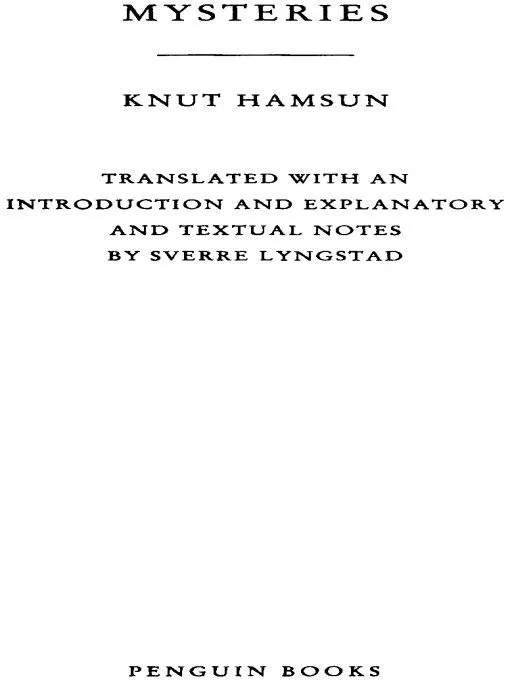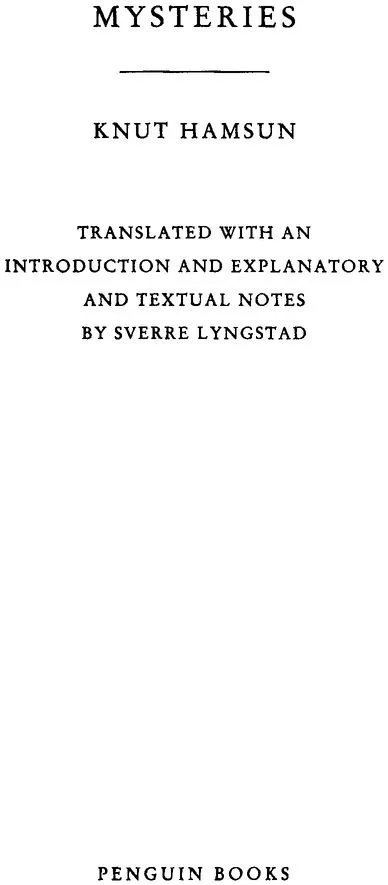Mysteries

Table of Contents
Title Page
Copyright Page
Dedication
Acknowledgements
Introduction
I
II
III
IV
V
VI
VII
VIII
IX
X
XI
XII
XIII
XIV
XV
XVI
XVII
XVIII
XIX
XX
XXI
XXII
XXIII
EXPLANATORY NOTES
TEXTUAL NOTES
FOR THE BEST IN PAPERBACKS, LOOK FOR THE

MYSTERIES
Knut Hamsun was born in 1859 to a poor peasant family in central Norway. His early literary ambition was thwarted by having to eke out a living—as a schoolmaster, sheriff’s assistant, and road laborer in Norway; as a store clerk, farmhand, and streetcar conductor in the American Midwest, where he lived for two extended periods between 1882 and 1888. Based on his own experiences as a struggling writer, Hamsun’s first novel, Sult (1890; tr. Hunger, 1899), was an immediate critical success. While also a poet and playwright, Hamsun made his mark on European literature as a novelist. Finding the contemporary novel plot-ridden, psychologically unsophisticated and didactic, he aimed to transform it so as to accommodate contingency and the irrational, the nuances of conscious and subconscious life as well as the vagaries of human behavior. Hamsun’s innovative aesthetic is exemplified in his successive novels of the decade: Mysteries (1892), Pan (1894), and Victoria (1898). Perhaps his best-known work is The Growth of the Soil (1917), which earned him the Nobel Prize in 1920. After the Second World War, as a result of his openly expressed Nazi sympathies during the German occupation of Norway, Hamsun forfeited his considerable fortune to the state. He died in poverty in 1952.
Sverre Lyngstad, Distinguished Professor Emeritus of English and Comparative Literature at the New Jersey Institute of Technology, Newark, New Jersey, holds degrees in English from the University of Oslo, the University of Washington, Seattle, and New York University. He is the author of many books and articles in the field of Scandinavian literature, including Jonas Lie (1977) and Sigurd Hoel’s Fiction (1984), coauthor of Ivan Goncharov (1971), and cotranslator of Tolstoy’s Childhood, Boyhood, and Youth (1968). Among his more recent translations from Norwegian are Knut Fadbakken’s Adam’s Diary (1988), Sigurd Hoel’s The Troll Circle (1992) and The Road to the World’s End (1995), Knut Hamsun’s Rosa (1997) and On Overgrown Paths (1999), and Arne Garborg’s Weary Men (1999). Dr. Lyngstad is the recipient of several grants, prizes, and awards and has been honored by the King of Norway with the St. Olav Medal and with the Knight’s Cross, First Class, of the Royal Norwegian Order of Merit. He has recently completed a critical study of Knut Hamsun’s novels.

BookishMall.com
Published by the Penguin Group
Penguin Group (USA) Inc., 375 Hudson Street, New York, New York 10014, U.S.A.
Penguin Books Ltd, 80 Strand, London WC2R ORL, England
Penguin Books Australia Ltd, 250 Camberwell Road, Camberwell, Victoria 3124, Australia
Penguin Books Canada Ltd, 10 Alcorn Avenue, Toronto, Ontario, Canada M4V 3B2
Penguin Books India (P) Ltd, 11 Community Centre, Panchsheel Park, New Delhi- 110 017, India
Penguin Group (NZ), cnr Airborne and Rosedale Roads, Albany, Auckland 1310, New Zealand
Penguin Books (South Africa) (Pty) Ltd, 24 Sturdee Avenue,
Rosebank, Johannesburg 2196, South Africa
Penguin Books Ltd, Registered Offices: 80 Strand, London WC2R ORL, England
First published in Penguin Books 2001
Translation, introduction, and notes copyright © Sverre Lyngstad, 2001 All rights reserved
Originally published in Norwegian as Mysterier
by P. G. Philipsens Forlag, Kobenhavn, 1892.
LIBRARY OF CONGRESS CATALOGING-IN-PUBLICATION DATA
Hamsun, Knut, 1859—1952.
[Mysterier. English]
Mysteries / Knut Hamsun ; translated with an introduction and
explanatory and textual notes by Sverre Lyngstad.
p. cm.
Includes bibliographical references.
eISBN : 978-1-440-67363-4
I. Lyngstad, Sverre. II. Title
PT8950.H3M913 2001
839.8’236—dc21
00-040651
http://us.penguingroup.com
For Karin and Ken
—S. L.
ACKNOWLEDGMENTS
I wish to thank the following persons for information concerning special usages, literary allusions, and biographical items in translating Mysteries and preparing the notes: Arnold and Kjellrun Lyngstad, Michael Rijssenbeek, Guy Rosa, and Dagfinn Worren. Special thanks go to Eléonore Zimmermann for her patience and encouragement during the period I was working on the translation and for reading the manuscript.
INTRODUCTION
At the time when Knut Hamsun was working on the novel that became Mysteries, he was also deeply, and busily, engaged in a critical crusade against the state of Norwegian literature. Already in 1890, the year his first novel, Hunger, appeared, he had published an essay in the journal Samtiden (The Contemporary) entitled “Fra det ubevidste Sjæleliv” (From the Unconscious Life of the Mind), in which he championed a new literary psychology, focused on the intangible, elusive aspects of consciousness, the very stream of thought, rather than its outcome or end results.
1 comment